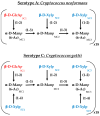Broad Antifungal Spectrum of the Pore-Forming Peptide C14R Against Cryptococcus and Candida Species from the WHO Fungal Priority Pathogens List
- PMID: 40559519
- PMCID: PMC12196350
- DOI: 10.3390/pathogens14060511
Broad Antifungal Spectrum of the Pore-Forming Peptide C14R Against Cryptococcus and Candida Species from the WHO Fungal Priority Pathogens List
Abstract
The World Health Organization (WHO) prioritized 19 fungal species based on the significant impact of these pathogens on human health, including the emergence of antifungal resistance, which highlights the necessity of finding new antifungal therapies. Among these novel therapeutic approaches, the antimicrobial pore-forming peptide C14R has shown to be promising against Candida albicans and Candida auris. In this study, the antifungal in vitro efficacy of C14R was assessed against six additional species from the WHO priority list, Cryptococcus neoformans, Cryptococcus gattii, Candida glabrata, Candida tropicalis, Candida parapsilosis and Candida krusei, as well as against Candida dubliniensis. This study shows that C14R has good antifungal activity against several clinical isolates of the studied species, with MIC values between 0.8476 and 10.88 µg/mL. Most notably, some of the studied isolates are resistant to commonly used antifungal drugs but are susceptible to the peptide. C14R showed, moreover, its capacity to disrupt Cryptococcus capsules, beyond its already proven capacity to disrupt plasma membranes, and its antifungal activity was not affected depending on the serotype or species assessed. The inclusion of basidiomycete and ascomycete yeasts allowed us to display the broad-spectrum potential of C14R, highlighting it as a promising candidate as an antifungal agent.
Keywords: C14R; Candida; Cryptococcus; antifungal resistance; antimicrobial peptides; cryptococcosis; invasive candidiasis.
Conflict of interest statement
The authors declare no conflicts of interest.
Figures



Similar articles
-
Pore-forming peptide C14R exhibits potent antifungal activity against clinical isolates of Candida albicans and Candida auris.Front Cell Infect Microbiol. 2024 Mar 27;14:1389020. doi: 10.3389/fcimb.2024.1389020. eCollection 2024. Front Cell Infect Microbiol. 2024. PMID: 38601736 Free PMC article.
-
Antifungal effects of andrographolide and its combination with amphotericin B against selected fungal pathogens.PeerJ. 2025 Jun 16;13:e19544. doi: 10.7717/peerj.19544. eCollection 2025. PeerJ. 2025. PMID: 40538737 Free PMC article.
-
Epidemiology and antifungal susceptibility of fungal infections from 2018 to 2021 in Shandong, eastern China: A report from the SPARSS program.Indian J Med Microbiol. 2024 Jan-Feb;47:100518. doi: 10.1016/j.ijmmb.2023.100518. Epub 2023 Dec 5. Indian J Med Microbiol. 2024. PMID: 38016503
-
[In vitro activity of voriconazole against yeast and algae isolates according to new resistance pattern cut-off points].Rev Esp Quimioter. 2006 Mar;19(1):21-33. Rev Esp Quimioter. 2006. PMID: 16688288 Spanish.
-
Activity of rezafungin against Candida auris.J Antimicrob Chemother. 2025 Jun 3;80(6):1482-1493. doi: 10.1093/jac/dkaf124. J Antimicrob Chemother. 2025. PMID: 40304092 Free PMC article. Review.
References
-
- WHO . WHO Fungal Priority Pathogens List to Guide Research, Development and Public Health Action. World Health Organization; Geneva, Switzerland: 2022. p. 48.
-
- Rajasingham R., Govender N.P., Jordan A., Loyse A., Shroufi A., Denning D.W., Meya D.B., Chiller T.M., Boulware D.R. The global burden of HIV-associated cryptococcal infection in adults in 2020: A modelling analysis. Lancet Infect. Dis. 2022;22:1748–1755. doi: 10.1016/S1473-3099(22)00499-6. - DOI - PMC - PubMed
MeSH terms
Substances
Grants and funding
LinkOut - more resources
Full Text Sources

